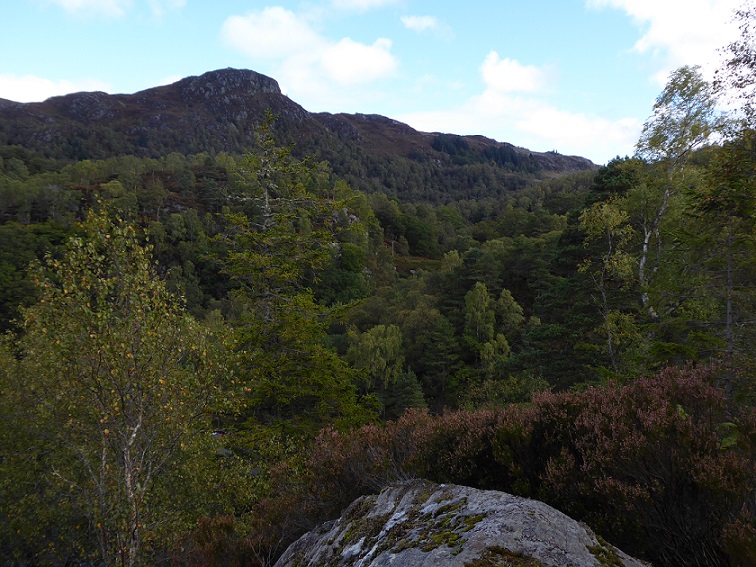
Ben A’an is a honeypot for hill walking, especially for “beginners”. Fantastic views, steep and craggy enough to provide a sense of adventure and not too far from urban populations, it is many people’s first hill. It has been very popular for some time and has become even more so due to the corona crisis. When I was there two weeks ago, at 9am we met a group of three returning from the summit. One had finished his night shift, driven over from Airdrie and was going back to bed. Later, taking a look at the path, I was overtaken by an Asian woman walking alone. The corona crisis has liberated the number and diversity of people visiting the countryside in a way that has never happened before. Brilliant!
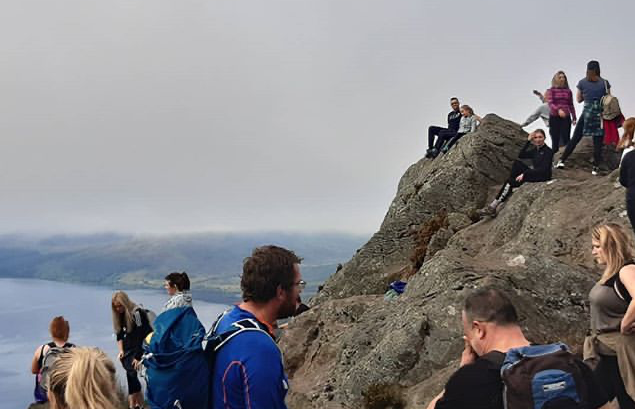
The problem, however, has been that those responsible for managing outdoor recreation in the countryside have been totally unprepared. That is nowhere better seen than at the Ben A’an which now is effectively only accessible by car along a winding road, a contrast to the 19th Century when the Trossachs were arguably the best connected tourist destination in the country . A more recent initiative, the Trossachs Trundler bus, enabled people to get to the hill by public transport. But that was sadly allowed to collapse despite transporting 10,000 people a season, which excluded those without cars from visiting the area and added to carbon emissions. Whether starting from Callander or Aberfoyle, the road, with all its bends, is far from safe for cycling while the path above Loch Venachar, which could provide an off-road cycling route, does not connect with Loch Achray. All this means that the only sensible option is to come by car, so that is what people do, along roads not designed to cope with the volume of traffic.
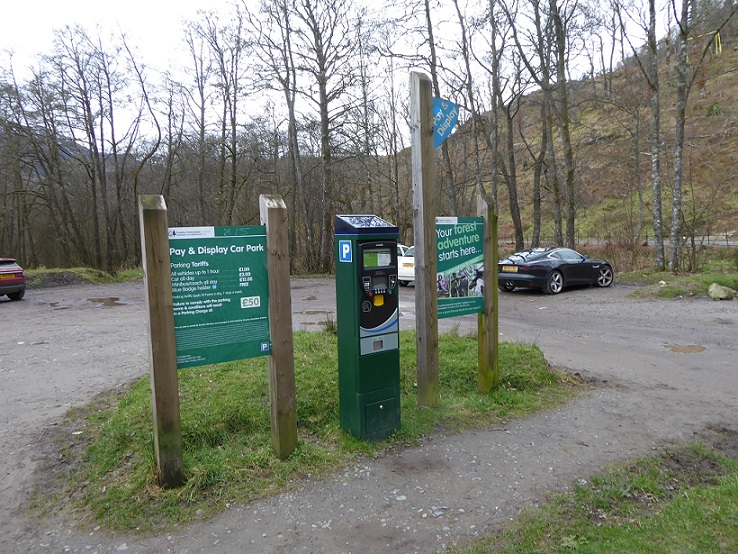
There is one main path up Ben A’ an and this is accessed from a car park that is almost entirely used by people wanting to walk up the hill. While large enough to meet demand mid-week off-season, for years there have been problems at popular times. Once people started traveling after lockdown, it was overwhelmed. People started parking an dropping off along the road:
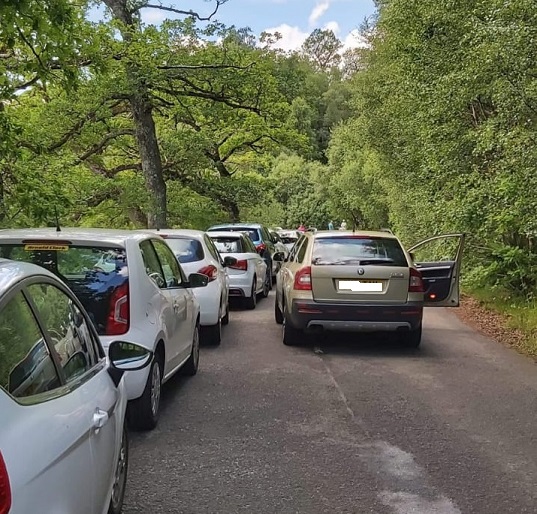
This created traffic problems for visitors and locals alike and, at times, could have made it very difficult for fire engines or ambulances to get through.
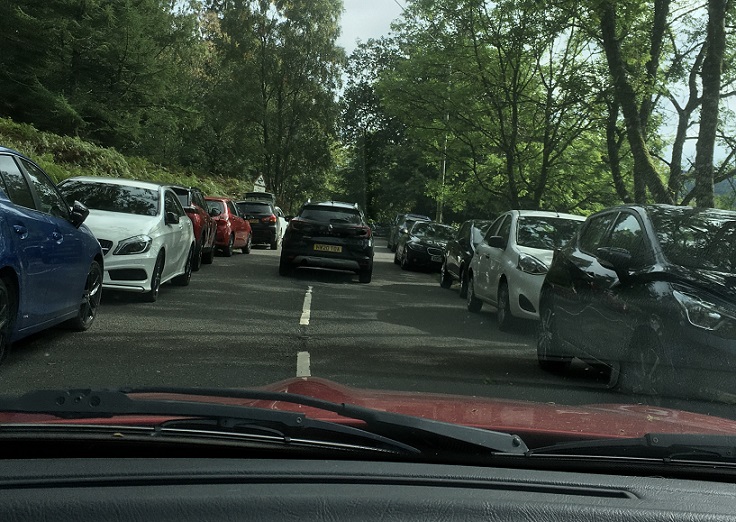
The response from the Loch Lomond and Trossachs National Park Authority was to blame visitors and, “working with” other public authorities, first an attempt was made to close the road. This not only prevented people from enjoying access rights, it cut off revenue for a number of tourism businesses, including Loch Katrine pier and was quickly abandoned. A clearway was then created and people fined for parking on the road. By one calculation, if all the people “ticketed” for parking on the Clearways at Ben Aa’n, Rowardennan and Bracklinn Falls on the fine weekend 10 days ago paid up at the reduced rate, Stirling Council would be £4350 better off. None of the money so far appears to be being re-invested in improved facilities that might address the problems.
 At Ben A’an part of the solution is obvious. Below the car park is an open boggy glade in the woodland which, in the absence of any public convenience, is used as a toilet area and is pretty disgusting. Unfortunately, Forest and Land Scotland, which own the site, have shown no interest in improving the current facilities – both mobile toilets and litter bins are required – or extending the car park themselves.
At Ben A’an part of the solution is obvious. Below the car park is an open boggy glade in the woodland which, in the absence of any public convenience, is used as a toilet area and is pretty disgusting. Unfortunately, Forest and Land Scotland, which own the site, have shown no interest in improving the current facilities – both mobile toilets and litter bins are required – or extending the car park themselves.

As a result I understand that the Sir Walter Scott Steamship Trust, based just down the road at Loch Katrine, has offered to take it on. How the LLTNPA planners respond, remains to be seen. The site is part of woodland Site of Special Scientific Interest and the planners have a long record of putting hurdles in the way of new recreational infrastructure, while approving large developments that really do damage the countryside.
The Ben A’an car park provides a sad example of our public authorities, the LLTNPA, Stirling Council, Forest and Land Scotland, have and continue to fail to work together to provide appropriate infrastructure for outdoor recreation. I wouldn’t mind if they jointly decided not to extend the car park but only if they would created a link cycle path now and started operating regular shuttle buses from Callander so that people could enjoy Ben A’an without their cars.
The Ben A’an path
Two years ago, the Ben A’an path was upgraded as part of the Mountains and People project. Financed by the Heritage Lottery fund, most of the money was spent on projects on public land managed at the time by Forest Enterprise Scotland, the predecessor of Forest and Land Scotland. There is a connection with the neglected car park, a lack of funds. While in 2018-19 £15m was spent on public forests in Scotland, £62.9m was spent on grants to private interests (see here). The £15m budget has to cover both commercial forest expenditure and conservation projects. Staff working for Forest and Land Scotland no longer have money to spend on public outdoor recreation infrastructure.
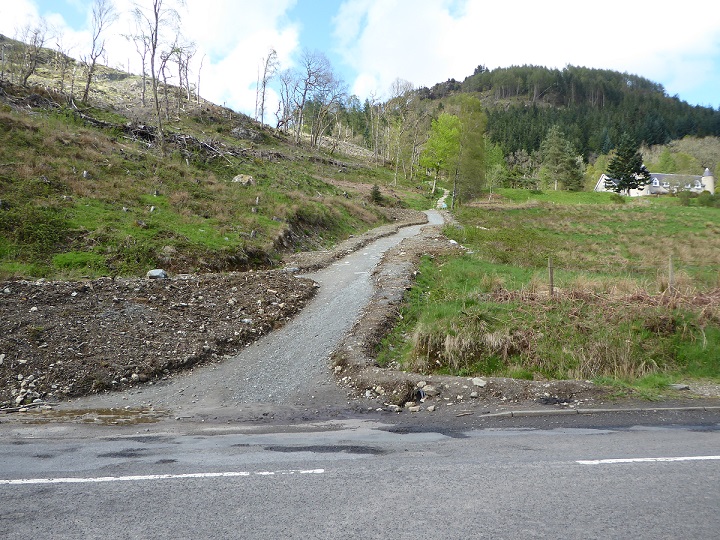
On account of Ben A’an’s popularity, it should have been obvious that any upgrade to the main path would have to be constructed to the highest of standards to withstand wear and tear. Either that or, alternatively, a number of routes could have been created to disperse walkers. A good circular route would effectively halve levels of usage ,while multiple paths, such as you find in the Lake District, would disperse people further. There are other routes up Ben A’An, including an old path from Loch Katrine, but not many people know about them and they are unpromoted and unmaintained.
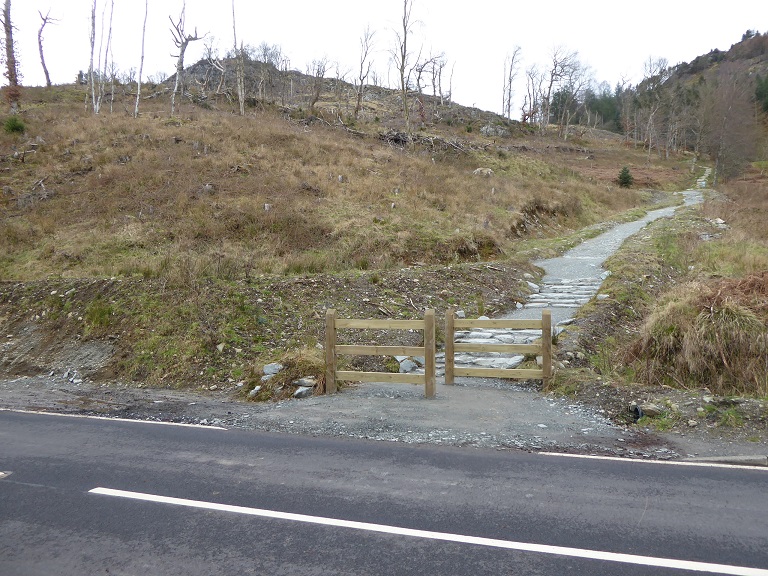
Unfortunately, staff at the Mountains and People Project were also under pressure to repair and upgrade paths on as many hills as possible and, given a fixed budget, that affected how the paths were designed and constructed. You can see evidence of how shortcuts were attempted from comparing the two photos above. The first section of path was originally constructed as a smooth slope but was too steep – like hill roads paths start to erode once steeper than 14° – hence the steps, which are far more expensive to construct. The safety fencing appears to have been installed only after someone realised that large numbers of people striding or whizzing onto a public road on their bikes was an accident waiting to happen.
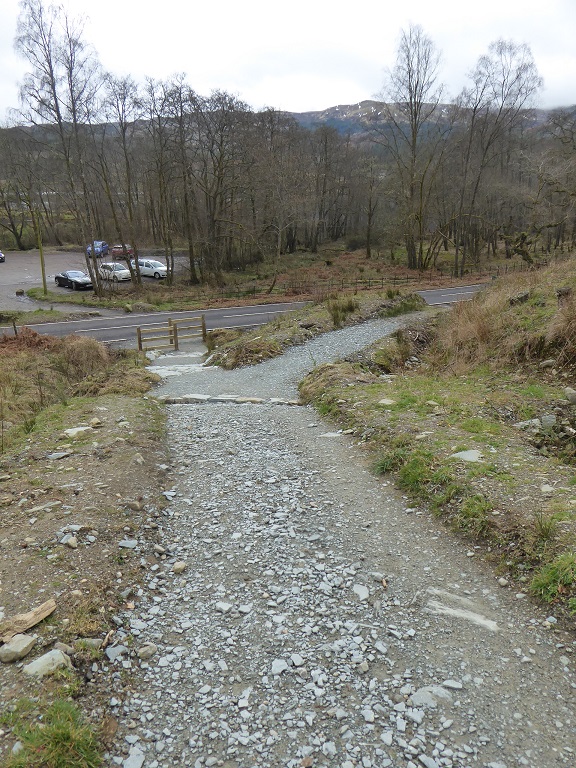
One wonders how long this path surface, with its heavy usage will last.
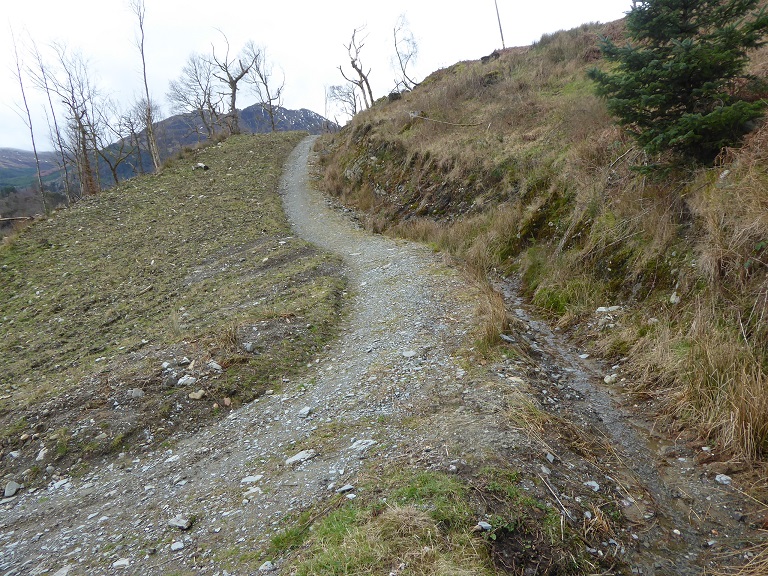
The old forest road could have provided a gentler route, at far less risk from erosion, with a new route constructed across the hillside to rejoin the main path above the first steep section. Intead the main path heads directly up the hill. A shorter route and therefore cheaper to construct, as long as this could be constructed by machine..
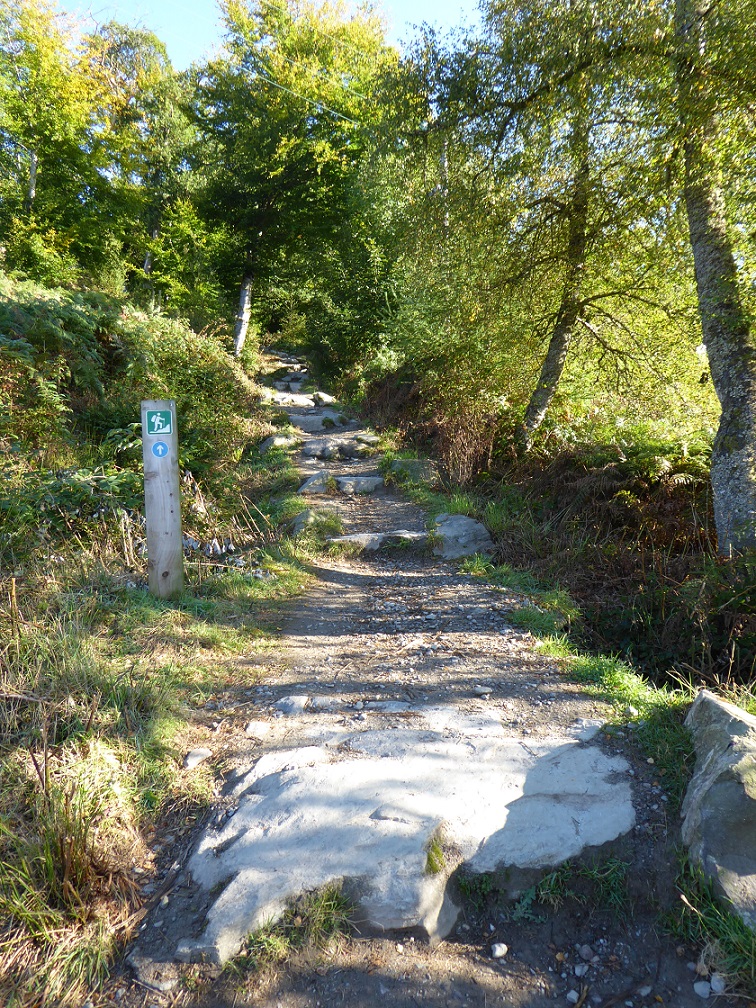
While it is amazing what skilled machine operators can do, steep paths pose challenges. They need to be designed so they don’t turn into watercourses and in ways that encourage walkers to remain on them. In this case, in a downpour, the angle of the inclined slope between the steps encourages water to flow down the path and there is no camber to shed the water on either side.
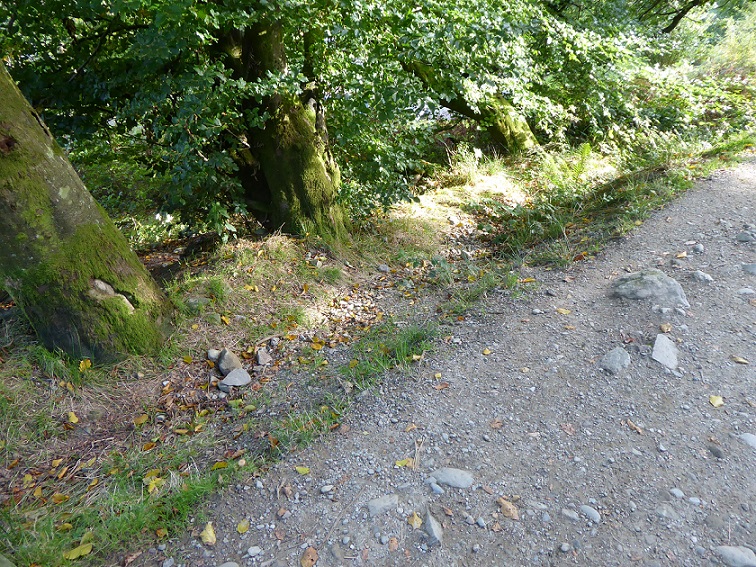 The eroded material ends up wherever the water takes it, often where the path bends.
The eroded material ends up wherever the water takes it, often where the path bends.
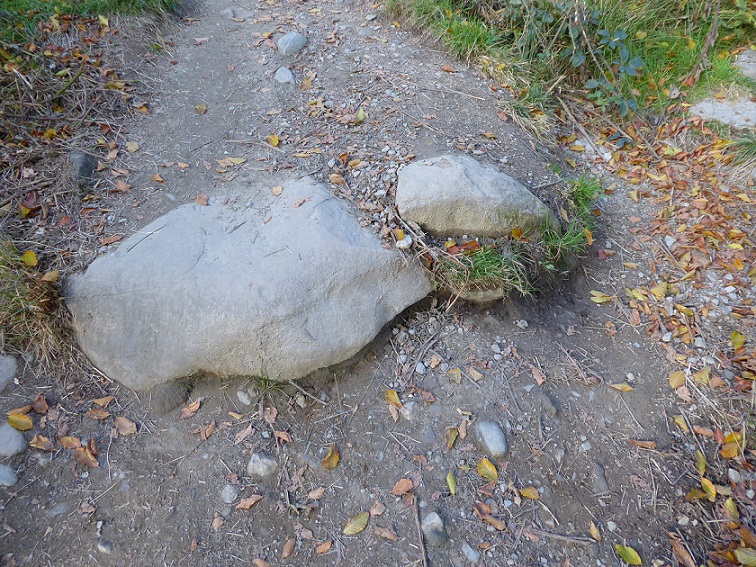
In terms of keeping people on the path, almost no walker likes high steps. They are hard work on the way up and jar the knees on the way down. If steps are greater than c10cm in height, people start trying to walk around them, as has happened here.
While erecting devil’s horns by each step can reduce the problem, they can be a bit too obvious. People will take considerable efforts to walk round them
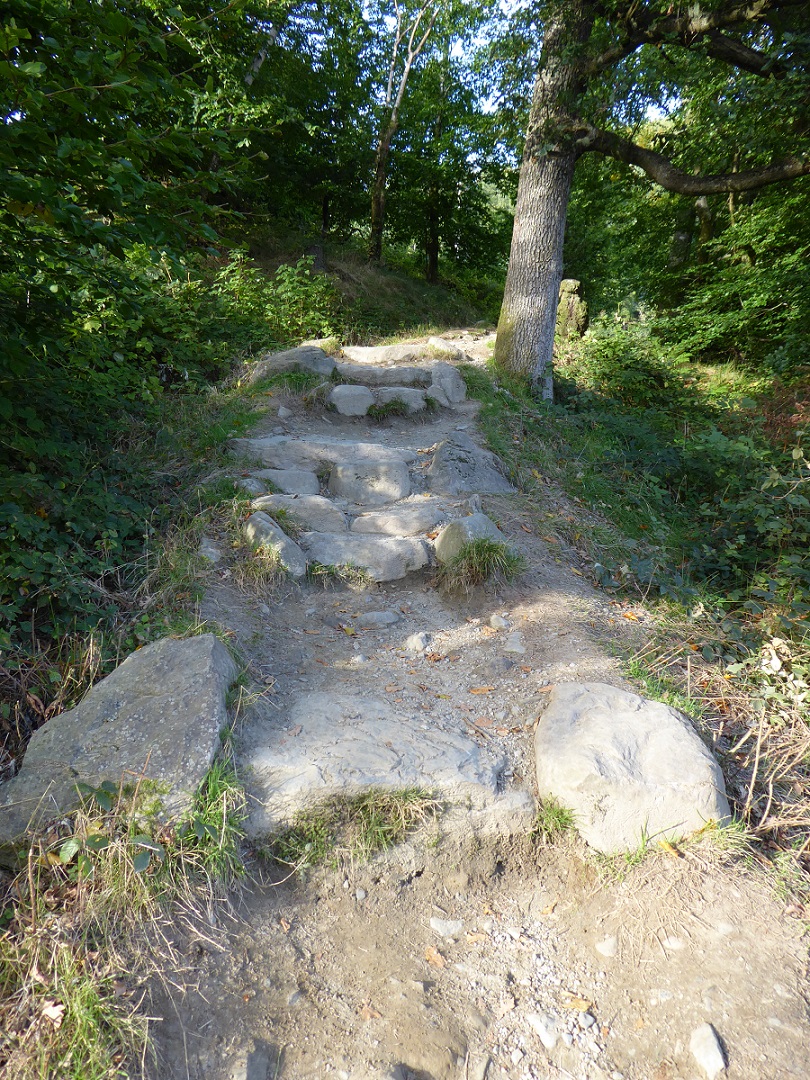
The problem is exacerbated if the ground below a step erodes increasing its height:
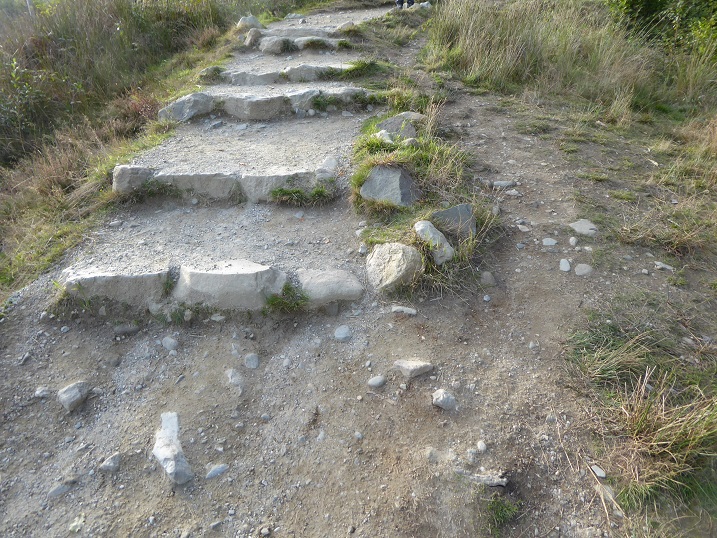
Note how the Devil’s Horns have been left as islands in a spreading path. One wonders what will have happened in another two and a half years. The evidence suggests that much of the Ben A’An path will have disintegrated and much of the investment wasted.
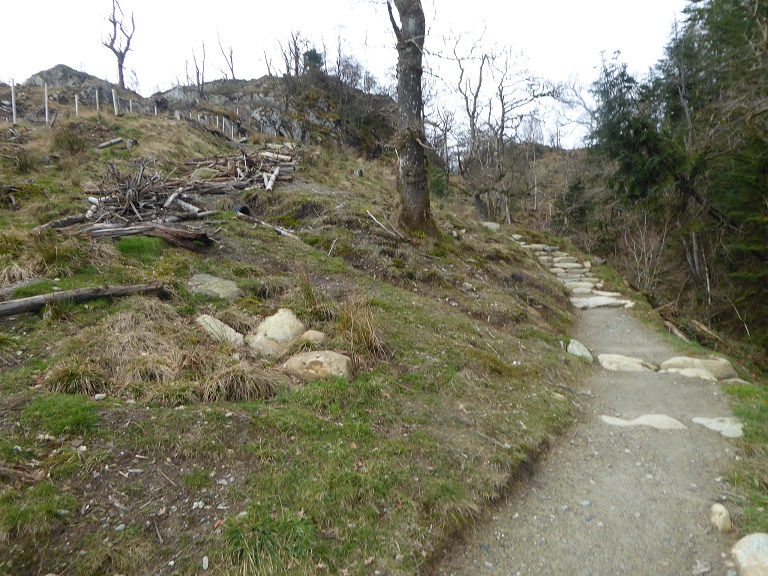
This steep section, about 800m after the start, began to erode very quickly after construction and as a result trainees from the Mountain and People project hand built the path you can see on the right. The logs were then placed over the steep section to prevent it being used as a shortcut. 18 months later, I don’t know why, the logs had been removed but the decomissioned section of path is now being used as a shortcut:
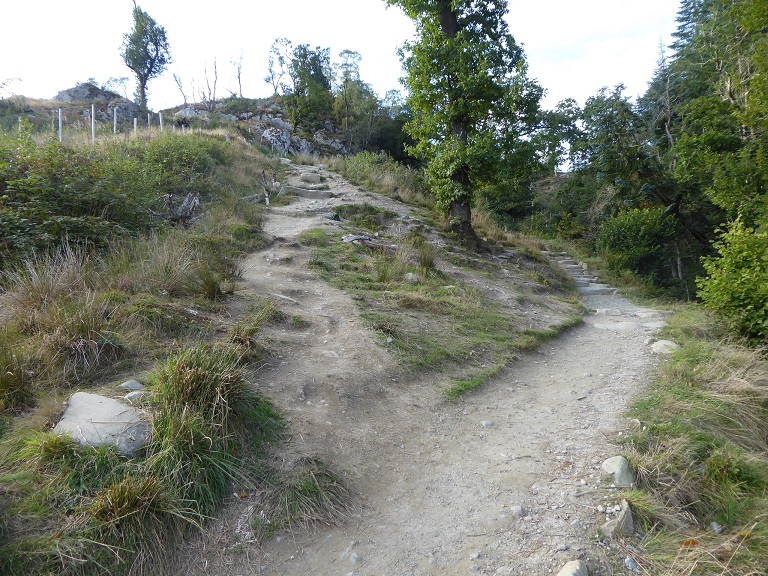
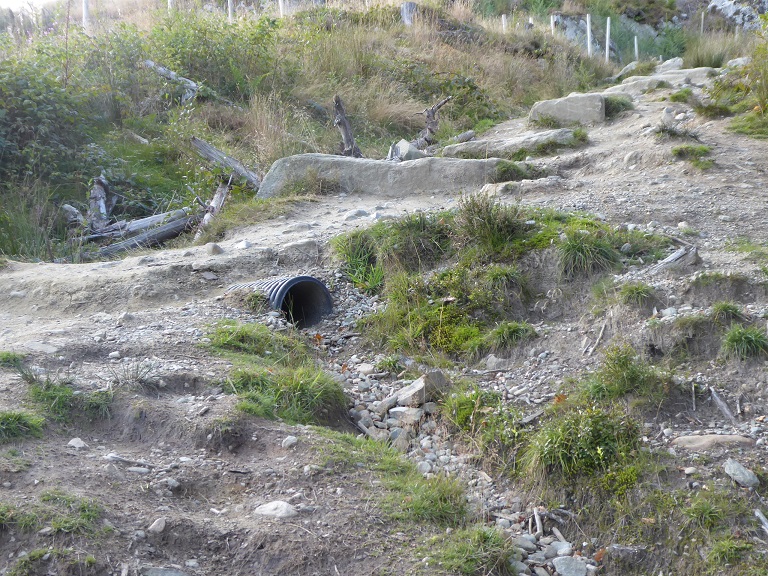
A classic example of the consequences of getting path design wrong. One wonders how much money would now be needed to repair this damage?.
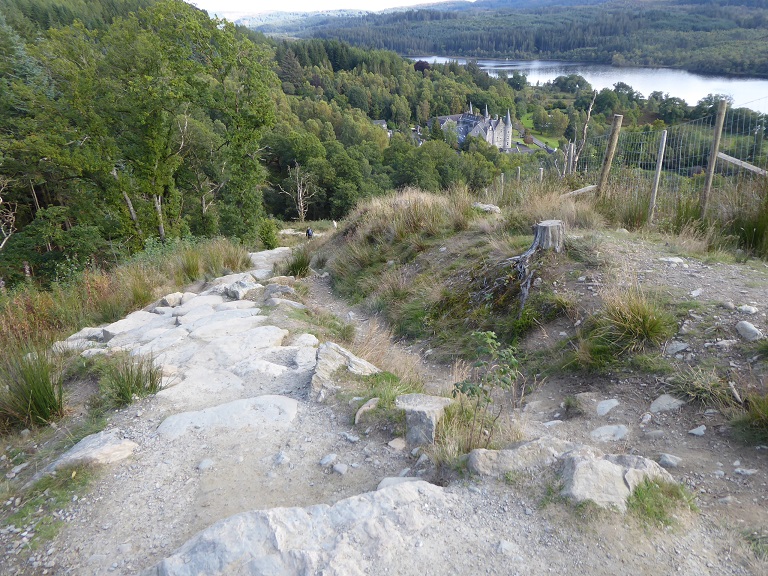
The problems are made worse because ,from above, the easiest line on the feet and knees appears to be down what was originally intended as a drainage ditch. Once you have stepped onto it, you are directed straight down the hillside and unlikely to want to step back onto the flight of steps to your left until you are beyond them and it is too late.
While I believe there are some very serious issues with the Ben A’an path, not all is bad and it is much better than Conic Hill (which I will consider in another post). The greatest problems are on the steep sections.
Elsewhere, there are examples of good design and effective construction:

The large flat stepping stone reduces the chance of accidents when the burn is high, an important consideration on a popular path often used by inexperienced walkers, while the blocks on either side help prevent the banks eroding.
There were also signs of maintenance:
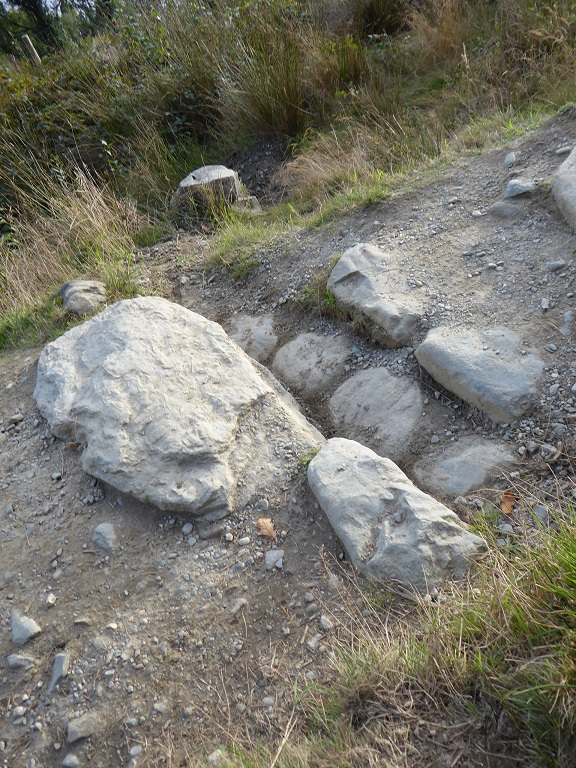
I found out subsequently from the Mountains and People website that there had been a volunteer work party a few days before my visit which had cleared out some blocked drainage:While maintenance like this is essential to keep paths in good condition, unfortunately in this case it appears to have been partly required because of yet more poor design. Unless a water bar is sufficiently angled, it will collects vegetation and other debris washed down from above and quickly block. There were several examples of horizontal water bars along the path.
What could we learn from what has gone wrong at Ben A’an?
To me Ben A’an epitomises everything that is wrong with visitor management in the National Park, our public authorities punish rather than help people to visit the countyside and provide infrastructure whose quality is far below what we should expect in a National Park. As to the solutions…………….
First, we need to consider visitor infrastructure and management as a whole. In the case of Ben A’An that means everything from why it is so popular (social media plays a role) and how people get there to parking capacity and the detailed design of paths. Then, when considering a preferred option, the consequences need to be considered. Having decided to “improve” the main path up the hill, the consequence was always likely to be even more visitors and the car park should have been upgraded at the same time as the path.
Second, that failing to invest and trying to cut costs, has serious consequences. We need proper costed investment plans for visitor infrastructure in the National Park. Grant Moir, now CEO of the Cairngorms National Park Authority, tried to do with the Five Lochs and East Loch Lomond Management Plans.These have since been abandoned by his successor, Gordon Watson, without any consultation and without any discussion by the LLTNPA Board. The LLTNPA has been floundering ever since. That is not the fault of frontline staff, it is a failure in leadership.
Third, that more specifically we need to invest properly in path work, design, construction and maintenance. With the Mountains and People project having ended, there is effectively no money for investing in pathwork in the National Park. The LLTNPA’s Board and senior management have so far failed to take any action to address this issue which will rapidly escalate, not least because of the numbers now visiting the countryside. As a first step they could call on Forest and Land Scotland, the largest landowner in the National Park, to stop shirking its responsibilities and join with them to make a case to the Scottish Government.
LLTNPA staff are still apparently working on its much delayed Outdoor Recreation Plan. When it appears, it should be judged it by the commitments made by the public authorities operating in the National Park how well it addresses the problems inadvertently caused by lots of people trying to go out and enjoy beautiful hills like Ben A’an.
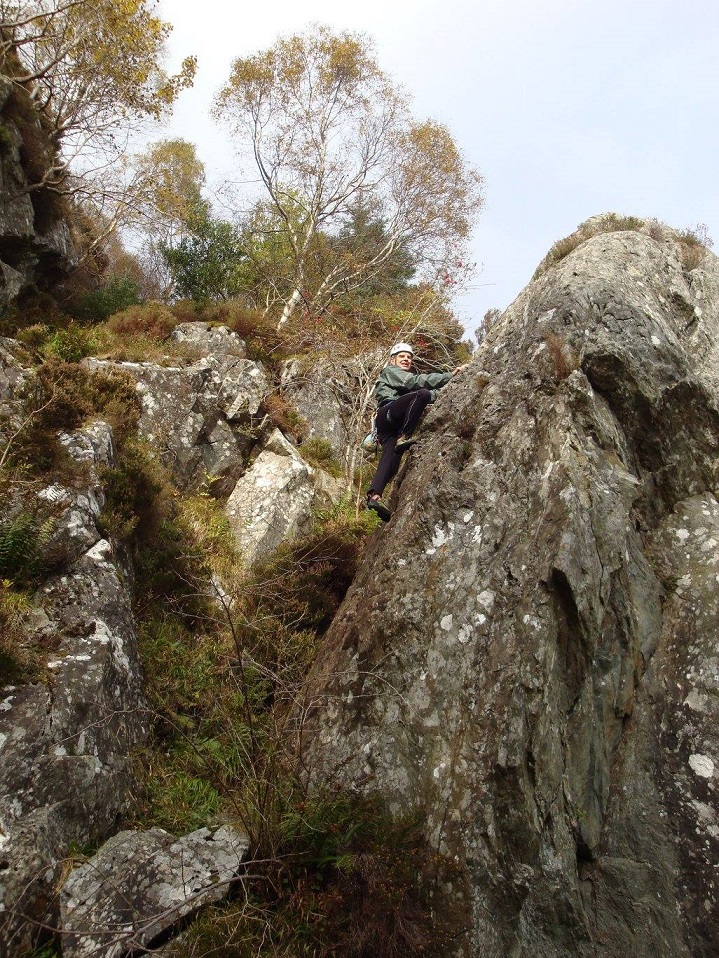

I become really saddened when I think of how we manage to allow our popular, beautiful landscape jewels become ruined. Our climate does not help, but it’s not rocket science to design and build intelligent protections for spots such as Ben A’an. It’s perhaps a cliche, but look at how other countries fare with this challenge. I’m effectively barred now from enjoying a once pleasurable walking/climbing site.
I used to climb here back in the day, when the timeshare was the Trossachs Hotel.
Ever increasing numbers is putting so much pressure on our wild places, I think we need to look at how our European partners manage their wild places & adopt their success stories, otherwise it’ll all be gone one day & impossible to recover
I used to love walking through the forestry approach to the higher levels of Ben A’an. So much of that is gone now and it has changed the entire character of the hill. As for the path and all the faults you highlight, the worst thing about it is that it’s such an eyesore.
Is it TV that’s made the walks so popular nowadays. It can’t just be car ownership as that would at the most count for a doubling of people. I was a regular walker of Ben Aa’n in the 80s when on the weekends you would possibly meet a few people on route, rather than nowadays , more like a Sauchiehall Street. A victim of its success I guess.